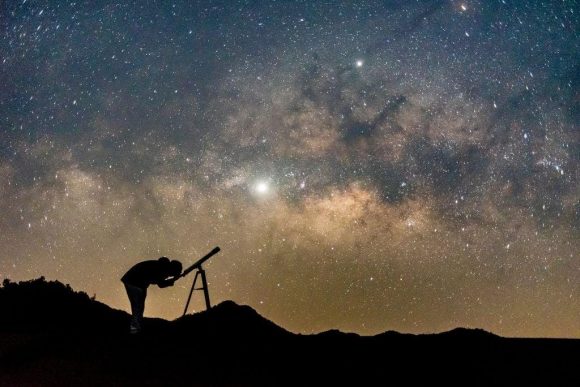The celestial vault will be the scene this 2023 of astronomical events that always impress and amaze the inhabitants of Earth.
The celestial vault will be the scene this 2023 of astronomical events that always impress and amaze the inhabitants of Earth,
especially when some of them occur every thousand years or are expected to happen for the last time.
Astronomical Oddity: A Hybrid Solar Eclipse
Eclipses occur when the Earth, the Moon, and the Sun align in such a way that the light from our star is blocked by one of the two celestial bodies.
According to experts, the types of solar eclipses are classified as total, when the Moon completely blocks the solar disk;
annular, the lunar disk blocks only the center of the solar disk and leaves the well-known ring of fire around it;
and partial, the Moon blocks only a portion of the solar disk.
But there is a fourth type, the hybrid solar eclipse, a combination of the other three and the rarest, most intriguing and possibly the most spectacular and interesting, and it is impossible to experience it in all its splendor.
That is,
a solar eclipse becomes an annular and total
, this occurs because the planet is curved, its natural satellite is positioned just the right distance from the planet so that the apex of its cone-shaped shadow is slightly above above the earth's surface, and this happens at the beginning and end of the eclipse path.
This astronomical oddity that occurs only a few times per century, will take place on April 20.
Observers at various points in the path of the eclipse will be able to experience different phenomena.
For example, if you watch a hybrid solar eclipse at sunrise or sunset, you might see a brief ring of fire;
if you see it at noon, that is, at the midpoint of the eclipse's path across the Earth's surface, you will experience totality.
The one scheduled for April will go from null to total and vice versa at two specific points, but both are in remote locations at sea.
Meanwhile, it will be seen exclusively as a total solar eclipse from the Exmouth Peninsula in Western Australia (up to one minute), Timor Leste (one minute 14 seconds) and West Papua (one minute nine seconds).
The latest hybrid occurred on November 3, 2013, and was visible as a total solar eclipse in central Africa, including northern Kenya and Uganda, the Congo, and the Democratic Republic of the Congo, while shipping in the mid-Atlantic Ocean also experienced the whole, up to a minute.
According to the astronomical calendar, three other eclipses will also be visible this year: a penumbral lunar eclipse on May 5, an annular lunar eclipse on October 14, and a partial lunar eclipse on October 28.
four supermoons
As happens every year,
in this 2023 four supermoons will be able to be seen, an
opportunity in which the natural satellite of the Earth will be closer and will be appreciated with greater size and brilliance.
Four decades ago astronomer Richard Nolle first described the term supermoon as an event that occurs when a full moon is also within 90 percent of its closest point to Earth, that is, its perigee.
According to experts, there are two types of supermoon: full, which can be seen in all its splendor, since it appears completely round and a little larger than normal, and new, one that cannot be seen at all, since it does not reflect the sunlight, but it is still very close to the planet.
According to the SeaSky observation platform, the Moon is normally 384,472 kilometers (km) from Earth, a distance that is shortened on supermoon nights, which makes it look bigger because of its proximity, not because it increases its size.
This year it is expected that we terrestrials will be able to appreciate four supermoons on these dates: July 3, 361,934 km away;
August 1 (357,530 km), August 31 (357,344 km) and September 29 (361,552 km).
Astronomers anticipate that if atmospheric conditions allow it, they can even be seen as Blood Moons, which happens when the visible side is dyed in a coppery, red or even purple color, like a large celestial bruise.
In order to observe this event, they advise looking for a clear place, without much light pollution or buildings that hinder its visualization.
Comet seen 50,000 years ago returns
Comet 2022E3, whose previous passage through the celestial vault occurred 50,000 years ago
, in the middle of the Upper Paleolithic, is approaching Earth, after reaching its perihelion (closest point to the Sun) on January 12, at a distance of 166 million kilometers.
On a journey through the inner solar system,
comet 2022 E3 will be at perigee, its closest point to our planet, just on February 1
, when it will be at a distance of 42 million kilometers, according to NASA.
Some astronomers suggest the possibility that, after this visit, the comet will be permanently expelled from the Solar System, making it perhaps the last chance to observe it.
They anticipate that it can be seen from the Northern Hemisphere, particularly in early February, using binoculars and telescopes when the sky is clear and in conditions of low light pollution.
2022E3 was named after the installation of the Zwicky Transient Facility, which operates the Samuel-Oschin telescope at the Palomar Observatory, in San Diego, California, United States, the place where it was first detected crossing near Jupiter in March of the year past.
Scientists describe comets as space snowballs made up of frozen gases, dust, and rocks that orbit the Sun.
As they get closer to our star, these objects are attacked with increasing amounts of radiation, releasing gases and debris.
This process forms a bright atmosphere around the comet (known as a coma) and two vast tails of gas and dust.
(Taken from Latin Press)
